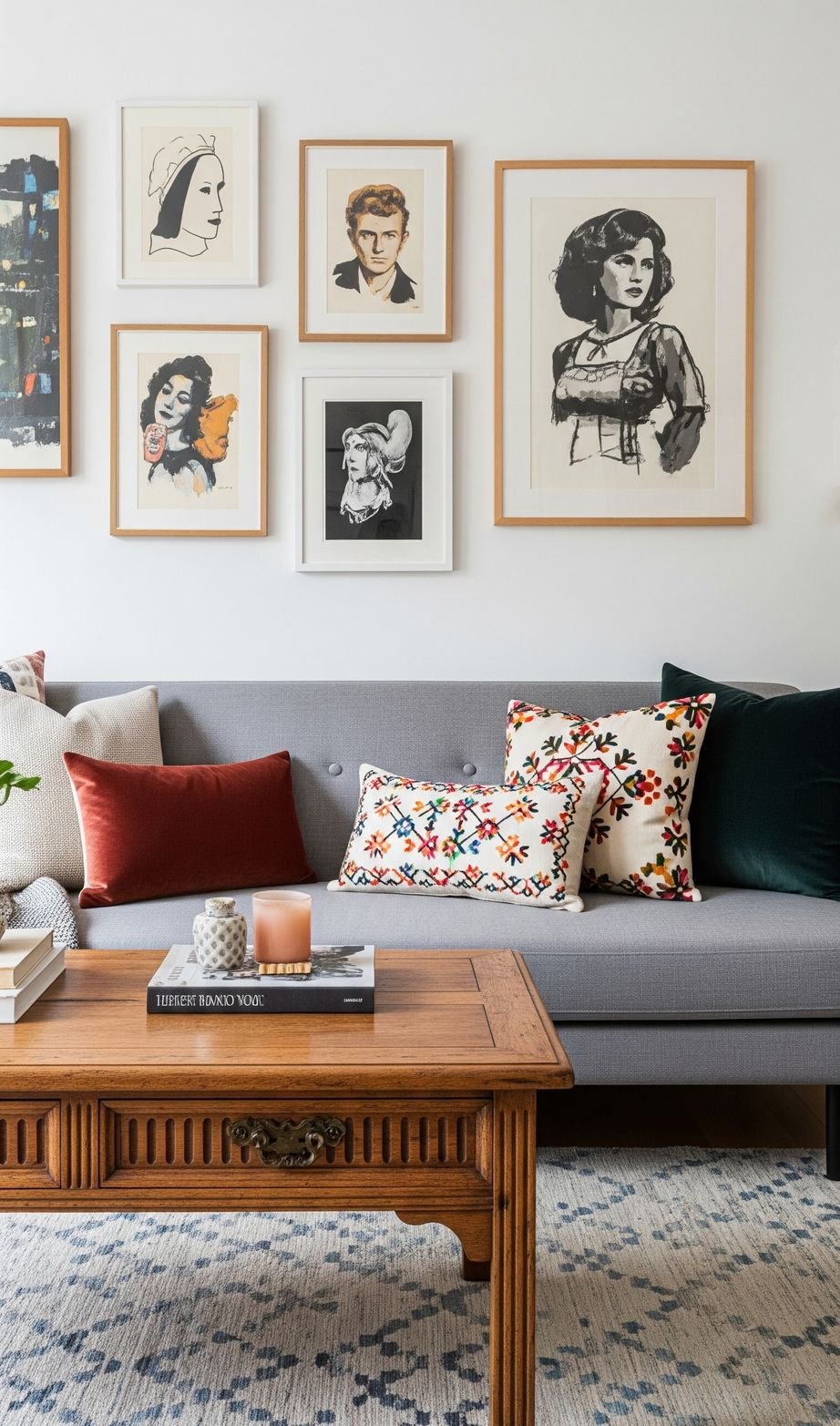Vintage Decor: How to Mix Old and New Without Clashing
Incorporating vintage decor into a modern home can add character, warmth, and a sense of history.
However, striking the right balance between old and new is crucial to avoid a space that feels cluttered or disjointed.
This article provides a comprehensive guide on how to seamlessly blend vintage and contemporary elements in your home decor.
Understanding Vintage Decor
Before diving into the “how-to,” it’s essential to define what constitutes “vintage” and understand its appeal.
Generally, items considered vintage are between 20 and 100 years old. This broad range encompasses various styles, from Art Deco glamour to mid-century modern simplicity and rustic farmhouse charm.
The Appeal of Vintage:
- Uniqueness and Character: Vintage pieces often possess unique details, craftsmanship, and patinas that are hard to find in mass-produced modern items. They tell a story and add personality to a space.
- Sustainability: Incorporating vintage furniture and decor is an environmentally conscious choice, giving pre-owned items a new lease on life and reducing demand for new production.
- Quality Craftsmanship: Many vintage items were built to last, often featuring superior materials and construction compared to some modern counterparts.
- Nostalgia and Personal Connection: Vintage items can evoke memories and create a connection to the past, adding a sentimental layer to your home.
Laying the Foundation: Identifying Your Style
The first step in successfully mixing vintage and modern decor is to define your overall style.
Do you lean towards minimalist modern with subtle vintage accents, or do you prefer a more eclectic look with a strong vintage presence?
Questions to Consider:
- What era(s) of vintage decor do you find most appealing? Art Deco, Mid-Century Modern, Victorian, Bohemian, Industrial?
- What are the key characteristics of your preferred modern style? Minimalist, Scandinavian, Industrial, Contemporary?
- What colors, materials, and textures do you gravitate towards in both vintage and modern pieces?
- What is the overall mood and atmosphere you want to create in your home?
Once you have a clear understanding of your stylistic preferences, you can begin to strategically select and integrate vintage pieces.
The Art of the Mix: Key Principles
Successfully blending vintage and modern decor relies on several key principles:
1. Establish a Dominant Style
While you’re mixing, it’s beneficial to have a dominant style that anchors the space. This prevents the room from feeling like a random collection of old and new items.
Choose whether you want your space to primarily feel modern with vintage accents, or vice versa.
For example, a modern living room with clean lines and neutral colors can be enhanced with a statement vintage coffee table or a gallery wall featuring antique prints.
Conversely, a room with predominantly vintage furniture can feel updated and fresh with modern lighting fixtures or contemporary artwork.
2. Balance Proportions and Scale
Pay close attention to the size and scale of your furniture and decor. Mixing different eras can sometimes lead to items with varying proportions.
Ensure that vintage and modern pieces complement each other in terms of their visual weight and how they occupy the space.
Avoid placing a delicate, petite vintage chair next to an oversized, bulky modern sofa, as this can create an imbalance.
Instead, consider pairing the vintage chair with a sleek, modern side table or arranging it as part of a balanced seating arrangement.
3. Create Visual Harmony Through Color and Texture
Color and texture are powerful tools for creating cohesion between vintage and modern elements. Choose a consistent color palette that ties the room together.
You can either opt for a neutral base with pops of color in both vintage and modern pieces or select a more vibrant palette where the different styles share common hues.
Similarly, consider the textures of your furniture and decor. Juxtaposing smooth, modern surfaces with the tactile richness of vintage textiles or the weathered patina of aged wood can add depth and interest.
However, ensure that the textures complement each other rather than clash.
4. Focus on Statement Pieces
Instead of filling a room with numerous small vintage items, consider investing in a few impactful statement pieces.
A striking vintage rug, a beautifully restored antique dresser, or a unique mid-century modern armchair can become focal points that elevate the entire space.
Pair these statement vintage pieces with simpler, more understated modern furniture to allow them to shine without overwhelming the room.
5. Embrace Contrast
While harmony is important, don’t be afraid to embrace contrast. The juxtaposition of old and new is what makes this style dynamic and interesting. Contrast can be achieved through:
- Form: Pairing the clean lines of modern design with the more ornate details of vintage pieces.
- Material: Combining the warmth of natural wood with the sleekness of metal or glass.
- Style: Placing a rustic farmhouse table in a contemporary dining room.
The key is to ensure that the contrast is intentional and creates a visually appealing tension rather than feeling accidental.
6. Integrate Through Details
Smaller decorative items can play a significant role in bridging the gap between vintage and modern styles. Consider incorporating:
- Throw pillows and blankets: Choose textiles that blend the color palettes or textures of your vintage and modern pieces.
- Artwork and photographs: Mix vintage portraits or landscapes with abstract modern art.
- Lighting fixtures: A modern floor lamp can complement a vintage sofa, or a vintage chandelier can add character to a contemporary dining area.
- Accessories: Display vintage vases, books, or collectibles on modern shelving units.
7. Edit and Curate
Mixing vintage and modern decor requires careful editing and curation. Avoid overcrowding your space with too many items, regardless of their age or style.
Regularly assess your decor and remove anything that doesn’t contribute to the overall aesthetic.
A well-curated space feels intentional and allows each piece to be appreciated.
Room-by-Room Application
Let’s explore how to apply these principles in different areas of your home:
Living Room
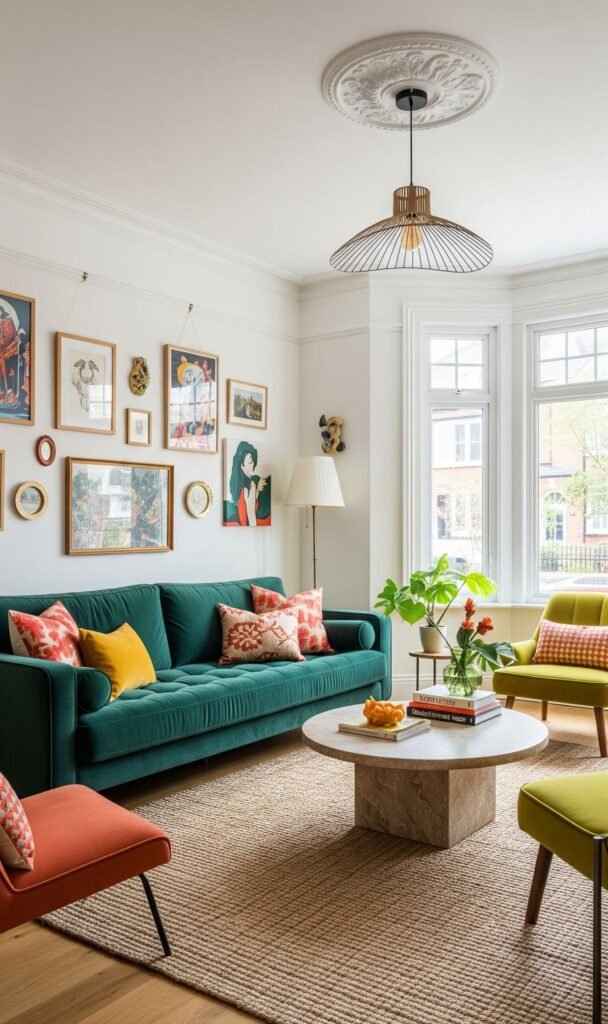
- Anchor with a Modern Sofa: A sleek, contemporary sofa in a neutral color provides a comfortable and stylish foundation.
- Introduce Vintage Accents: Add a vintage coffee table, a pair of mid-century armchairs, or a vintage rug to inject character.
- Mix Throw Pillows and Textiles: Combine modern geometric patterns with vintage floral prints or textured fabrics.
- Create a Gallery Wall: Hang a mix of vintage artwork, antique maps, and contemporary prints in similar frames for a cohesive look.
- Incorporate Vintage Lighting: A vintage floor lamp or table lamp can add a touch of old-world charm to a modern setting.
Dining Room
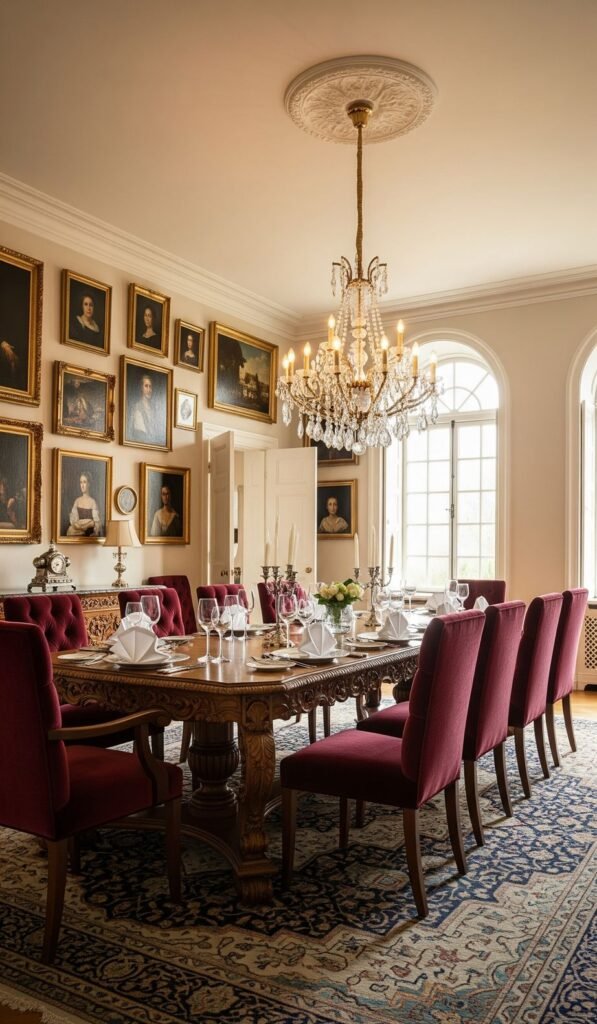
- Pair a Vintage Table with Modern Chairs: A beautifully aged wooden dining table can be striking when surrounded by sleek, modern dining chairs.
- Introduce a Vintage Sideboard or Buffet: This functional piece can add storage and a touch of vintage elegance.
- Mix Tableware: Combine modern plates and glassware with vintage serving dishes or silverware.
- Hang a Statement Lighting Fixture: A vintage chandelier or pendant light can be a stunning focal point above a modern dining table.
- Display Vintage Decor: Arrange vintage candlesticks, vases, or decorative objects on a modern console table.
Bedroom

- Choose a Vintage Bed Frame: A beautifully carved wooden or upholstered vintage bed can be a luxurious centerpiece.
- Use Modern Bedding: Crisp, modern linens in neutral colors can provide a clean contrast to a vintage bed frame.
- Incorporate Vintage Nightstands or Dressers: These pieces add character and functionality.
- Mix Throw Pillows and Blankets: Combine soft, modern textures with vintage lace or embroidered details.
- Add Vintage Artwork or Mirrors: Hang a vintage mirror above a modern dresser or display vintage prints on the walls.
Kitchen
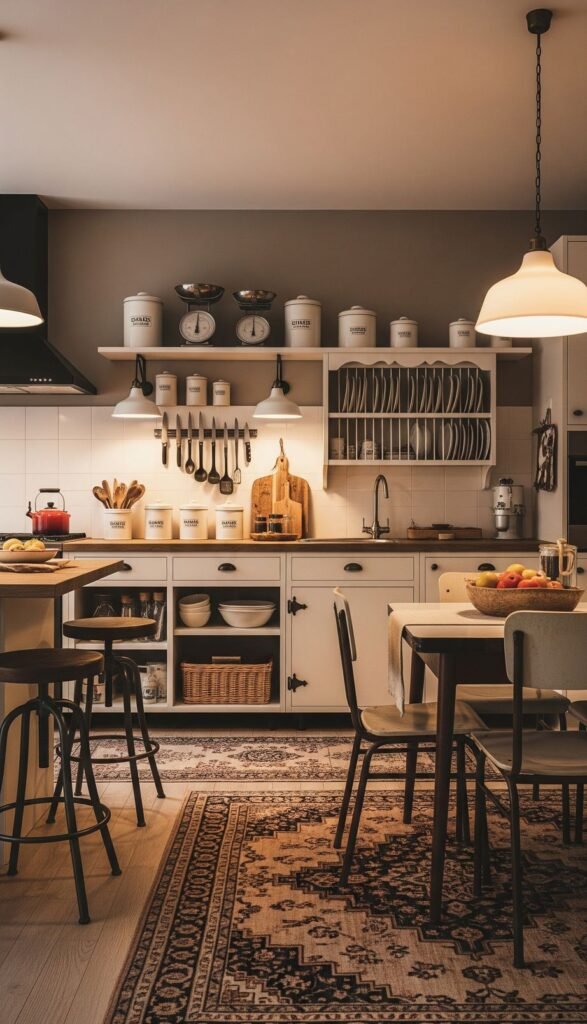
- Incorporate Vintage Accessories: Display vintage canisters, scales, or kitchen tools on open shelving.
- Use a Vintage Rug: A durable vintage rug can add warmth and character to a modern kitchen floor.
- Introduce Vintage Seating: A set of vintage bar stools or a small vintage dining table and chairs can create a charming breakfast nook.
- Mix Modern Cabinetry with Vintage Details: Consider adding vintage-style hardware to modern cabinets or displaying vintage plates on a plate rack.
- Hang Vintage-Inspired Lighting: Pendant lights with a vintage aesthetic can complement modern kitchen design.
Bathroom
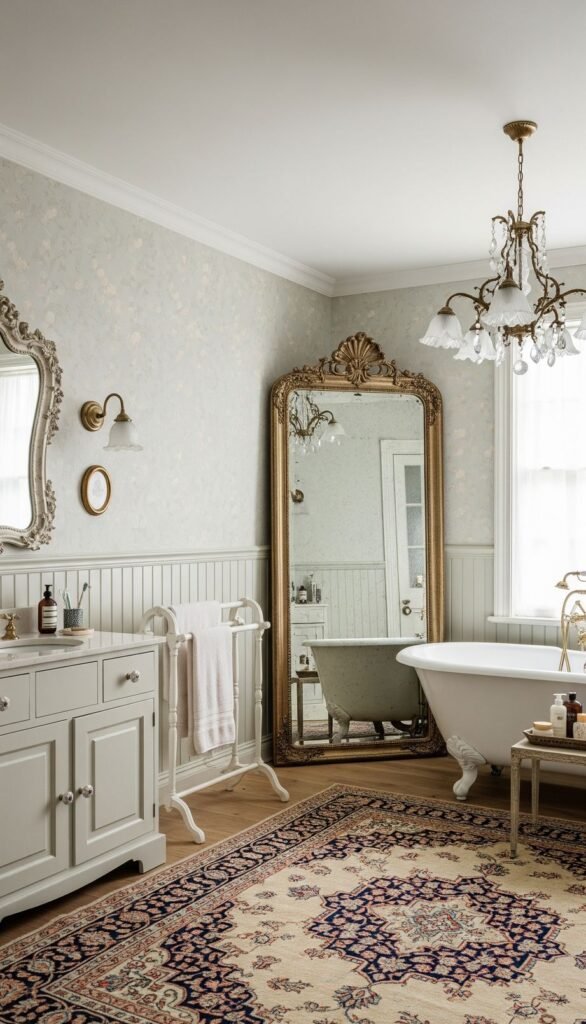
- Install a Vintage Mirror: A decorative vintage mirror can add a touch of elegance to a modern bathroom.
- Use Vintage Accessories: Display toiletries in vintage glass jars or use antique trays to organize items.
- Incorporate Vintage Lighting: A vintage wall sconce or pendant light can enhance the ambiance.
- Add a Vintage Rug: A small vintage rug can add warmth and texture to a tiled floor.
- Consider Vintage Plumbing Fixtures (with caution): While striking, ensure vintage plumbing is compatible with modern systems and in good working order.
Finding Vintage Treasures
Sourcing authentic vintage pieces is part of the fun. Here are some places to look:
- Antique Stores and Markets: These are treasure troves of unique and one-of-a-kind items.
- Thrift Stores and Charity Shops: You can often find hidden gems at affordable prices.
- Estate Sales and Auctions: These can be great sources for larger furniture pieces and collections.
- Online Marketplaces: Websites like Etsy, eBay, and Chairish offer a wide selection of vintage items from individual sellers and dealers.
- Friends and Family: Sometimes, the best vintage finds are inherited or passed down through generations.
Caring for Vintage Items
Once you’ve acquired your vintage treasures, proper care is essential to preserve their beauty and longevity.
- Cleaning: Clean vintage items gently, using appropriate methods and products for their specific materials.
- Repair: Address any necessary repairs promptly to prevent further damage. Consider professional restoration for valuable pieces.
- Protection: Protect vintage furniture from direct sunlight and extreme temperatures. Use coasters and placemats to prevent stains and scratches.
Avoiding Clashes
While the goal is to create an interesting mix, it’s important to avoid a cluttered or jarring look. Here are some tips to prevent clashes:
- Don’t Overdo It: Too many disparate styles in one space can feel chaotic. Focus on a cohesive blend.
- Consider Scale and Proportion: Ensure that vintage and modern pieces are visually compatible in size.
- Pay Attention to Condition: Avoid incorporating vintage items that are heavily damaged or poorly maintained, as they can detract from the overall aesthetic.
- Edit Ruthlessly: Regularly review your decor and remove anything that doesn’t contribute to the desired look.
- Trust Your Eye: Ultimately, the success of mixing vintage and modern decor depends on your personal taste and how the elements feel together in your space.
Conclusion
Mixing vintage and modern decor is a rewarding way to create a home that is both stylish and personal.
By understanding the appeal of vintage, defining your style, and applying key principles of balance, harmony, and contrast, you can seamlessly integrate old and new elements.
Embrace the unique character of vintage finds and enjoy the process of curating a space that reflects your individual taste and tells your story.
Remember to edit carefully and trust your instincts to create a home that feels both timeless and contemporary.
